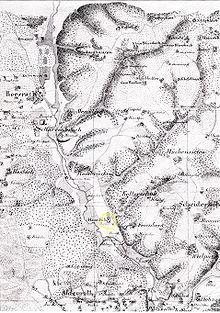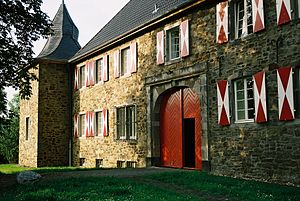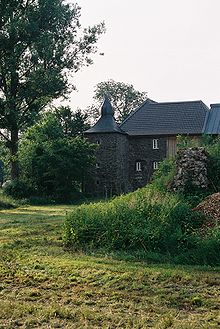House Sülz
| House Sülz | ||
|---|---|---|
|
House Sülz |
||
| Alternative name (s): | sulsa, Stolt (en) - or Staël-Sülz | |
| Creation time : | around 700 | |
| Castle type : | Niederungsburg | |
| Conservation status: | Small remains of the wall (main castle) ; Significant parts preserved (bailey from the 18th century) |
|
| Construction: | Quarry stone | |
| Place: | Lohmar | |
| Geographical location | 50 ° 52 '19 " N , 7 ° 12' 6" E | |
| Height: | 70 m above sea level NHN | |
|
|
||
The house Sülz (also: Burg Sülz ) is a former fortified house in North Rhine-Westphalia . It belongs to the city of Lohmar and is located in the Rhein-Sieg district . The former moated castle stands in the valley floor of the Sülz , at an altitude of 70 m above sea level. NHN between the districts of Lohmar-Donrath and Rösrath -Rambrücken.
history
The former knight's seat , the establishment of which probably dates back to around 700 AD , is mentioned for the first time in writing in a document from Archbishop Anno II of 1075; It is one of the oldest aristocratic residences on the right bank of the Rhine of the former Siegkreis . In previous years, the property belonged to the Count Palatine , but after 1064 it was donated to the newly founded Siegburg Abbey , which owned it for more than three centuries. Between 1396 and 1401, the Staël von Holstein family , who had their ancestral seat at Holstein Castle near Nümbrecht , came to Sülz Castle, as can be seen from the 1585 certification of a document dated August 24, 1401. The first owner was the Bergisch hereditary steward and knight Wilhelm Staël von Holstein, Herr von Eulenbroich ; over the following centuries belonged to his son William, his half-brother Dietrich Staël von Holstein (for 1476 documented), (documented in 1486), his son Wilhelm and finally Wilhelm Staël, Johan Stayll as his son and heir and steward to Wesseling (documented 1528) , to the gentlemen at Haus Sülz. With the latter, the male tribe of the family died out.

In the middle of the 16th century, Wilhelm's nephew Adolf von Bellinghausen inherited the property, but with the marriage of his daughter Helene in 1582 it fell to the von Zweiffel family , who were also the owners of Wissem Castle in Troisdorf . In 1641 Helene von Zweiffel married the imperial colonel and electoral Cologne privy councilor Reinart von Hillen zu Helden and lived with him at Haus Sülz until 1670. In 1766 their grandchildren sold the property to Johann Paul La Valette St. George, who had the medieval castle house and the outer bailey demolished in order to erect new, representative buildings. However, only the southwest wing with the gate passage and a three-storey corner tower was realized. Even before 1827 the family sold the estate with a total of 701 acres to the Düren factory owner Leopold Schoeller ; At that time 23 people lived at two fireplaces on Haus Sülz (1829), in 1840 there were 12 (one fireplace) and in 1872 nine people lived in one household. In 1885 Sülz had a residential building and ten residents. Before 1900 the property was sold on to the Linden family from Haus Venauen .
In 1935 ownership changed from Count Waldenberg to Balthasar and Hans Menzen. In the style of the right outer bailey, Hans Menzen built the left part of the building, which is now a listed building, including the archway and corner tower (northwest wing) with the business part behind. In 1960 the property was sold to Josef Jockram.
investment
The quarry stone buildings built in the 18th century are now located on the site of the former outer bailey, and the north-west wing was added around 1936. The southwest front is flanked by two corner towers with onion domes . The red and white shutters on the street side create an antiquated contrast to the modern functional buildings recently added in the inner courtyard.
To the southeast of the roughly rectangular complex, less than 100 meters away, the few remains of the main castle wall can be found in a heavily overgrown fallow area.
The entire facility can only be viewed from the outside.
Remarks
- ↑ after Rutt, Theodor (arr.): Rösrath in the course of history . Rösrath community (publisher), Rösrath-Hoffnungsthal 1970, as early as 1330
- ↑ see the website of the Thomas Baron Stael von Holstein family ( memento of the original from September 27, 2007 in the Internet Archive ) Info: The archive link has been inserted automatically and has not yet been checked. Please check the original and archive link according to the instructions and then remove this notice. , accessed May 30, 2007
- ↑ after Rutt, Theodor, s. o. in 1547
- ^ Community encyclopedia for the Kingdom of Prussia from 1885
literature
- Heinrich Hennekeuser: Lohmar community . Rhenish Association for Monument Preservation and Landscape Protection , Cologne 1980, ISBN 3-88094-328-1 . (= Rheinische Kunststätten, No. 234)
- The district administrator of the Rhein-Sieg-Kreis (Hrsg.): Yearbook of the Rhein-Sieg-Kreis 2007 . Edition Blattwelt, Niederhofen 2006, ISBN 3-936256-24-1 .
- Wilhelm Pape: Settlement and home history of the community Lohmar . Pressure u. Publishing company Helmut Grümer, Lohmar 1983.
Web links
- Entry on Sülz in the scientific database " EBIDAT " of the European Castle Institute
- Entry on Sülz in the private database "Alle Burgen".
- Haus Sülz's website has a history




